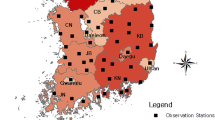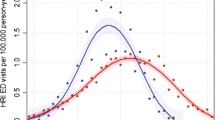Abstract
Extreme heat events have occurred more frequently in China in recent years, leading to serious impacts on human life and the health care system. To identify the characteristics of individuals with heat-related illnesses in China during the summer of 2013, we collected the data from the Heat-related Illness Surveillance System in Chinese Center for Disease Control and Prevention (China CDC). A total of 5758 cases were reported in the summer of 2013, mostly concentrated in urban areas around the middle and lower reaches of the Yangtze River. We found a difference in age distribution of percentage of deaths from heat-related illness between males and females. Severe cases in males mostly occurred in the age group 45–74 years but in females mostly in the age group over 75. A distributed lag non-linear model had been used to identify population vulnerabilities in Ningbo and Chongqing. The results show that there was a clear positive relationship between maximum temperature and heat-related illness, and the heat effect was nonlinear and could last for 3 days. The elderly and males in the range of 45–64 years old might be the most vulnerable people of heat-related illness in China. We also highlighted some deficiencies of the surveillance system, such that the reported data were not accurate, comprehensive, or timely enough at this stage.



Similar content being viewed by others
References
Altman DG, Bland JM (2003) Interaction revisited: the difference between two estimates. BMJ 326(7382):219
Bai L, Cirendunzhu WA, Dawa X, Liu Q (2014a) Temperature and mortality on the roof of the world: a time-series analysis in three Tibetan counties, China. Sci Total Environ 485–486:41–48. doi:10.1016/j.scitotenv.2014.02.094
Bai L, Ding G, Gu S, Bi P, Su B, Qin D, Xu G, Liu Q (2014b) The effects of summer temperature and heat waves on heat-related illness in a coastal city of China, 2011–2013. Environ Res 132:212–219. doi:10.1016/j.envres.2014.04.002
Basu R (2009) High ambient temperature and mortality: a review of epidemiologic studies from 2001 to 2008. Environ Health: Glob Access Sci Source 8:40. doi:10.1186/1476-069X-8-40
Becker JA, Stewart LK (2011) Heat-related illness. Am Fam Physician 83(11):1325–1330
Bouchama A, Knochel JP (2002) Heat stroke. N Engl J Med 346(25):1978–1988. doi:10.1056/NEJMra011089
CDC (2008) Heat-related deaths among crop workers—United States, 1992–2006. Morb Mortal Wkly Rep 57(24):649–653
Gamble JL, Hurley BJ, Schultz PA, Jaglom WS, Krishnan N, Harris M (2013) Climate change and older Americans: state of the science. Environ Health Perspect 121(1):15–22. doi:10.1289/ehp.1205223
Gasparrini A (2011) Distributed lag linear and non-linear models in R: the package DLNM. J Stat Softw 43(8):1–20
Gasparrini A, Armstrong B, Kenward MG (2010) Distributed lag non-linear models. Stat Med 29(21):2224–2234. doi:10.1002/sim.3940
Howe AS, Boden BP (2007) Heat-related illness in athletes. Am J Sports Med 35(8):1384–1395. doi:10.1177/0363546507305013
Huang C, Barnett A, Wang X, Tong S (2012) The impact of temperature on years of life lost in Brisbane, Australia. Nat Clim Chang 2:265–270
IPCC (2013) Summary for policymakers. In: Climate change 2013: the physical science basis contribution of Working Group I to the fifth assessment report of the intergovernmental panel on climate change. Cambridge University Press, Cambridge
Kilbourne EM, Choi K, Jones TS, Thacker SB (1982) Risk factors for heatstroke. A case–control study. Jama 247(24):3332–3336
Kondo M, Honda Y, Ono M (2011) Growing concern about heatstroke this summer in Japan after Fukushima nuclear disaster. Environ Health Prev Med 16(5):279–280
Na W, Jang JY, Lee KE, Kim H, Jun B, Kwon JW, Jo SN (2013) The effects of temperature on heat-related illness according to the characteristics of patients during the summer of 2012 in the Republic of Korea. J Prev Med Public Health = Yebang Uihakhoe chi 46(1):19–27. doi:10.3961/jpmph.2013.46.1.19
O’Neill MS (2003) Air conditioning and heat-related health effects. Appl Environ Sci Public Health 1:9–12
Perry AG, Korenberg MJ, Hall GG, Moore KM (2011) Modeling and syndromic surveillance for estimating weather-induced heat-related illness. Journal of environmental and public health 2011:750236. doi:10.1155/2011/750236
Piver WTAM, Ye F et al (1999) Temperature and air pollution as risk factors for heat stroke in Tokyo, July and August 1980-1995. Environ Health Perspect 107(11):911
Semenza JC, Rubin CH, Falter KH, Selanikio JD, Flanders WD, Howe HL, Wilhelm JL (1996) Heat-related deaths during the July 1995 heat wave in Chicago. N Engl J Med 335(2):84–90. doi:10.1056/NEJM199607113350203
Shanks NJ, Papworth G (2001) Environmental factors and heatstroke. Occup Med 51(1):45–49
Tan J, Zheng Y, Song G, Kalkstein LS, Kalkstein AJ, Tang X (2007) Heat wave impacts on mortality in Shanghai, 1998 and 2003. Int J Biometeorol 51(3):193–200. doi:10.1007/s00484-006-0058-3
Tan J, Zheng Y, Tang X, Guo C, Li L, Song G, Zhen X, Yuan D, Kalkstein AJ, Li F (2010) The urban heat island and its impact on heat waves and human health in Shanghai. Int J Biometeorol 54(1):75–84. doi:10.1007/s00484-009-0256-x
White-Newsome JL, Sánchez BN, Parker EA, Dvonch JT, Zhang Z, O'Neill MS (2011) Assessing heat-adaptive behaviors among older, urban-dwelling adults. Maturitas 70(1):85–91
Widodo D (2005) Heat stroke. Acta Med Indones 37(1):39–42
Ye X, Wolff R, Yu W, Vaneckova P, Pan X, Tong S (2012) Ambient temperature and morbidity: a review of epidemiological evidence. Environ Health Perspect 120(1):19–28. doi:10.1289/ehp.1003198
Acknowledgments
This study was supported by the National Basic Research Program of China (973 Program) (Grant No. 2012CB955504).
Competing interests
The authors declare that they have no competing interests.
Author information
Authors and Affiliations
Corresponding authors
Additional information
Shaohua Gu and Cunrui Huang contributed equally to this work.
Electronic supplementary material
Below is the link to the electronic supplementary material.
ESM 1
(DOCX 616 kb)
Rights and permissions
About this article
Cite this article
Gu, S., Huang, C., Bai, L. et al. Heat-related illness in China, summer of 2013. Int J Biometeorol 60, 131–137 (2016). https://doi.org/10.1007/s00484-015-1011-0
Received:
Revised:
Accepted:
Published:
Issue Date:
DOI: https://doi.org/10.1007/s00484-015-1011-0




